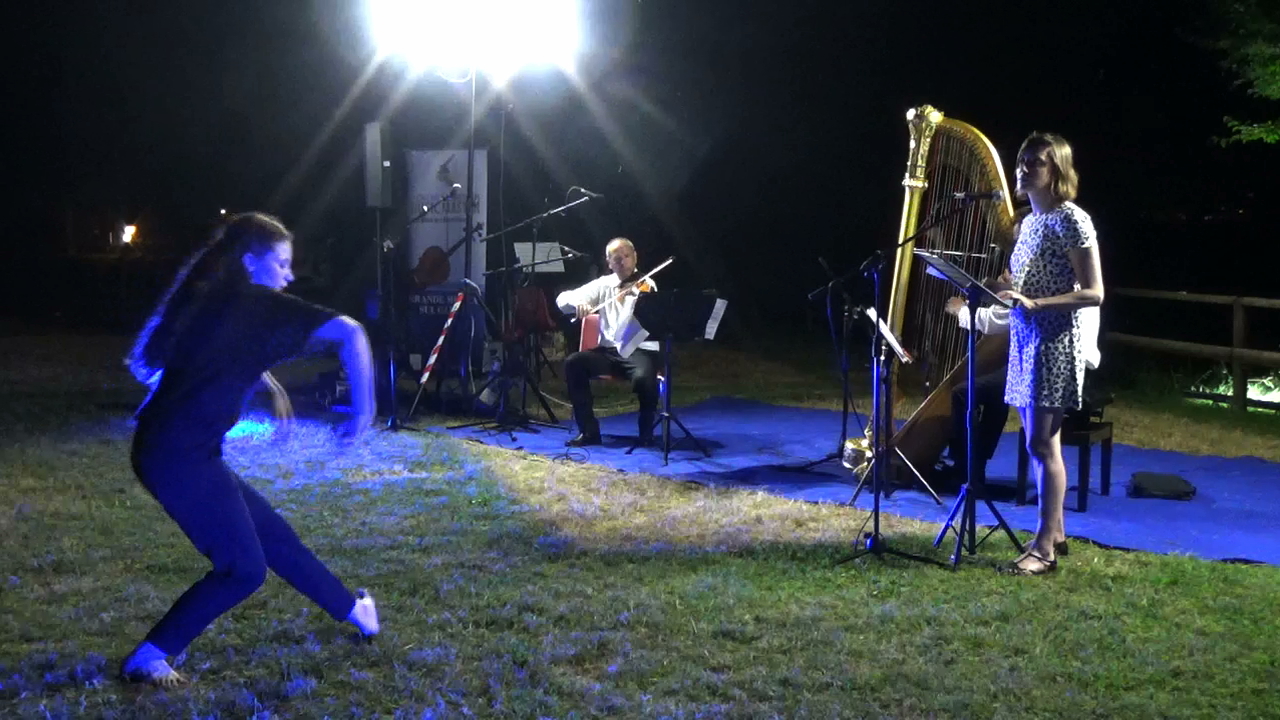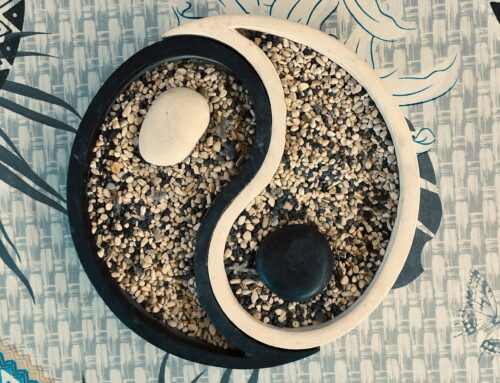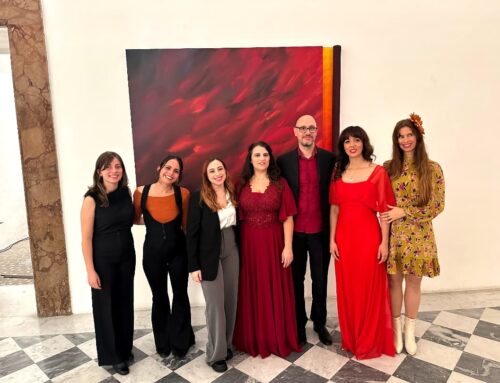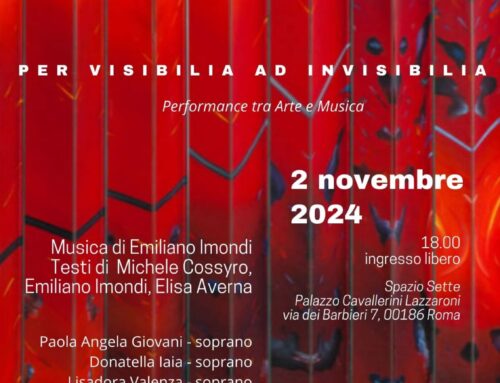The Tao of Water: great success last July in Sirmione on the shores of Garda’s Lake
The Tao of Water: Great success on July 13th for the event “Musica d’Acqua” (Water Music) in the splendid setting of the San Vito Park in Sirmione (Bs, Italy). For the occasion, among other works commissioned, was performed my last composition: a melologue for harp, viola, narrator and dancer freely based on a text by the chinese sage Zhuang Zi written about in the fourth century. B.C.
An “Artistic” Experience
After a busy week of musical and stage rehearsals I can declare myself truly happy with the show that, on the evening of July 13th, took place in the San Vito Park, on the shores of Garda,’s Lake in Sirmione. It turned out to be a wonderful experience of sharing and growth since the show included, besides my melologue Il Tao dell’Acqua, the performance of seven contemporary compositions written on the theme of “Water”, a characteristic element of the territory. Although among us composers there were many differences in the languages, approaches and interpretations to the theme, everything was very coherent at the end. What could represent a weak point of the show has shown itself as its most relevant aspect. Just the work done together, in the meetings that took place during the year between us composers and the coordinator Mauro Montalbetti, have created a fertile environment to make sure that our ideas (musical and otherwise) in the realization of the show went towards a unique direction. This has, over time, defined an “overall vision” making sure that the group slowly thought as a single entity transforming all our different facets into vital elements for the artistic success of the project. At one point in the general rehearsal we were all surprised by the strength and cohesion of the show as a whole. It was the fruit of the intense work, but above all of how the sharing and the intellectual and artistic honesty sought from the beginning had “secretly” shaped the soul of our music giving us a show in which we all could feel a part of ourselves.
Speaking of Music? Main Taoist Concepts Represented in the Work
For the creation of the Tao of the Water the text, The Full Autumn of Zhuang Zi, was divided by me into a prologue, an epilogue and in the 6 parts of the dialogue in wich the Lord of the River asks questions about the philosophy of the Tao to Ruo the Lord of the Yellow Sea who responds in an allegorical way according to the principles of the Taoist doctrine.

- the real and unspeakable TAO, the formless which generates the form and where the form returns. According to the Taoist circular thought, it is the matrix behind the Universal Order, the existence behind the Tao literally means “the Way” and represents the original “fruitful chaos” from which life will be born.
- WU JI is the second manifestation of the Tao and emerges from it. Wu Ji means “non-pole”, the embryo of an existence that is not yet polarized and differentiated. In fact, its symbol is an empty circle.
- The TAI JI is instead the third and last manifestation of the Tao: literally Tai Ji means the “great pole” (or large beam that supports the becoming of the phenomenal universe) and represents the unity that contains in itself the differentiation. The symbol gives the idea of a tide that proceeds and recedes, of the fusion of white into black and of black into white, of union in the opposition and in general of movement. In the center of the black zone there is a white point and vice versa, this wants to highlight the fact that in each of the two components Yin and Yang there is the germ of the other (under the snow the seed of the summer is already alive ).
When the vitality contained in Tai Ji takes shape, the “ten thousand beings” appear, the forms defined and distinct from each other, the contraposition and loss of unity, man and woman, light and darkness, the day and night, the high and the low etc. The Yin and the Yang.
Life manifests itself in duality from the moment it is conceived and formless until the moment of the last breath in which it returns to the mother earth. Every living being is in duality: joy and pain, action and rest, strength and weakness, life and death, love and hate. Within these pairs of opposites no one can exist without the other.
- YIN is the state of inertia, of receptivity, of energetic potentiality; the dark, mysterious and profound aspect. It is symbolized by the WATER for its characteristic to go down and adapt to every shape.
- YANG is activity, action, the expression of energetic potentiality, the luminous, superficial and manifest aspect; it is flashed by the FIRE for its nature of incessant upward movement, lightness and instability.
On this basis we can distinguish in all the phenomena of the universe a YIN aspect and a YANG aspect creating an infinite number of opposite pairs.
Aesthetic Direction
The piece aims to emphasize the principles, the symbology of the 5 elements and the two different aspects of YIN and YANG in which the life, the Taoist doctrine and the philosophical reasoning of the two characters are manifested. Every concept in the text is expressed according to the principle of opposites which are always two sides of the same unity, and precisely the search for this unity, this non-distinction is the goal that man tries to achieve by following the Tao, “ Street”.
Compositive Principles and Relationship with the Concepts
As far as harmonic systems are concerned, I preferred the free use of a “spectralist” framework or background, with reference to the series of natural harmonics, to define the two “opposite polarities” and the musical material – or rather the pitches of the notes – to use.
pentatonic of C: C-D-E-F#-G-A
pentatonic of F#: F#-G#-A#-C-C#-D#
To reflect even more the characteristics and the relations between the YIN and the YANG I then chose to use three complementary and opposite harmonic systems, in a certain relation, among them:
- tonal → spectral: the two scales of six sounds and the two harmonic series all centered on the notes Do and Fa #
- spectrum → inverse spectrum: the two harmonic series with the inverted intervals
- tonal harmony → negative harmony: harmony derived from the two hexaphonic scales and the one derived from their inversion (negative or inverted harmony)
The systems were used for the formation of harmonies and for the extrapolation of series or scales useful for the creation of melodic gestures and complete melodies. The idea, however, is that of an interchange and a conpenetration between systems without interruption.
The rest comes from the relationship with the text that, with its references, suggestions and allegories, has gradually suggested to me the movements and the direction that the music should have followed. This is for me the “mysterious” part of composition and creativity … and that I hope will be found in the Tao of Water
Acknowledgments
Without going too far I would like to take this opportunity to thank some people and friends: first of all the Maestro Mauro Montalbetti for the artistic organization, the technical supervision and the demonstrated availability; all the staff and management of the Scuola di Musica del Garda, the DOC Servizi and the Municipality of Sirmione who commissioned and allowed the realization of the show; obviously the audience for the great reception that has reserved for the “new music”; all the performers who brought to life what otherwise would have remained “on paper”:
Barbara Roganti (reciting voice and dramaturgy) and Chiara Taviani (choreography and dance) for their availability and professionalism;
The musicians: Martino Panizza (harp) and Giancarlo Bussola (viola) for the commitment and professionalism shown in performing my piece;
The first harpist of the Teatro alla Scala of Milan Luisa Prandina for the precious supervision during the rehearsals and her availability;
All the other musicians who made the show possible: Laura Marchese (harp), Diletta Sereno (harp), Jone Diamantini (viola)
Obviously a special thanks to all the composers and authors, now close friends, with whom I had the honor and the pleasure of collaborating: Vlady Bianchini, Lorenzo Di Vora, Vittorio Cristini, Tommaso Fakhreddine, Sabrina Felli, Marco Murgioni, Silvia Sandrini and Massimo Migliorati hoping to be able to work with all of you again in the future.






